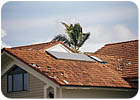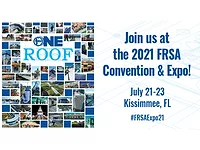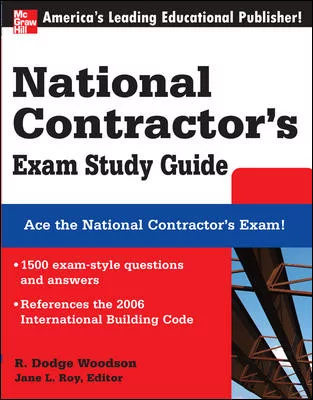One Nation, Under Code
Despite great strides toward a unified building code throughout the country, the goal of roofing contractors having to learn just one basic set of codes is a distant dream.

 Despite great strides toward a unified building code throughout the country, the goal of roofing contractors having to learn just one basic set of codes is a distant dream. Despite 48 states adopting the International Building Code - including some states that have had modest experience with codes in the past - enforcement is largely a local issue. Many communities vary widely on issues like licensing, wind requirements and zoning. While many contractors and manufacturers look forward to negotiating a more level landscape, in reality the impact of building codes still depends on the municipality.
Despite great strides toward a unified building code throughout the country, the goal of roofing contractors having to learn just one basic set of codes is a distant dream. Despite 48 states adopting the International Building Code - including some states that have had modest experience with codes in the past - enforcement is largely a local issue. Many communities vary widely on issues like licensing, wind requirements and zoning. While many contractors and manufacturers look forward to negotiating a more level landscape, in reality the impact of building codes still depends on the municipality.
Even when states like Louisiana adopted the IBC, the parishes along the Gulf Coast didn't adopt wind and flood requirements before Hurricane Katrina struck last August. Many pockets of the country have a frontier mentality about construction, but disasters like Katrina are forcing jurisdictions to demand better building practices in order to save lives and protect property.
"It takes a disaster before people realize the importance of building codes," says Jennifer Gibson, public relations specialist with the International Code Congress, the governing body for IBC, established in 1994. "Hurricane Katrina has shown that codes do work."

That last factor is rather unpredictable, yet it resonates loudly with those who have seen firsthand the horrors that simple exclusions can create. If a nightclub in Rhode Island had used flame-resistant sound barriers, a rock band's pyrotechnic display may have turned out to be a stupid stunt rather than a catastrophe that claimed 100 lives. The aftermath of Hurricane Katrina proved to any nonbelievers the critical nature of some of the most basic provisions. ICC has opened a permanent office in Lafayette, La., to assist the region in adopting more stringent codes and ensuring enforcement for the rebuilding effort.
"A lot of those places had no codes at all," says Gibson. "A similar effort is under way in Mississippi. There's a lot of resistance to codes in that state. I'm sure that our staff will work to get the codes adopted in Mississippi."
As the frantic rebuilding continues across four states, federal, state and local officials are striving to ensure that any construction taking place in harm's way will produce structures that are robust. Gibson says that codes not only protect lives and property, but they can also reduce property insurance and repair costs. She points to figures that show for every $1 invested in following the latest codes, there's a $4 to $7 return in reduced damage after an event.
In addition to the states, over 16,000 jurisdictions have adopted the IBC, while some states like Hawaii and California are taking their time. Both states subscribed to BOCA's model code, which preceded the IBC, and both license roofing contractors. Gibson expects California, which explored using a different model code written by the National Fire Protection Association (NFPA), to adopt the IBC soon, along with model codes for residential construction and fire prevention. Alabama, Ohio, Illinois and Arizona recently adopted the IBC, and the ICC also tests contractors in 21 states.
The Louisiana legislature recently adopted codes for buildings, residences, existing buildings, mechanical systems, and fuel gas. All buildings repaired after Hurricanes Katrina and Rita must follow the codes, and, starting in 2007, any construction statewide must be in compliance. Homes and business along the Gulf Coast must now withstand winds up to 150 mph in an effort to better survive what some experts speculate will be more frequent storms in the coming years.

"We have a very strong role with regard to code officials in this state," says Steven Rocklin with the New York Department of State Division of Codes. "All code officials in this state have to complete a basic training program."
Although New York does not license contractors (other than alarm installers) and never joined the BOCA code body, the state has long been committed to quality building practices. New York City had fire and safety codes as far back as the 1800s and has been the site of dramatic examples of how building design, construction and maintenance can save or cost lives. For instance, the basic way egresses in commercial buildings are designed today is derived in part from the horrible experience of 146 women dying in the 1911 fire at the Triangle Shirtwaist Co. in New York City.
While Rocklin says that the state adheres to nearly all the provisions in the IBC, there were a number of modifications when the state adopted the IBC in 2003. Since state law mandates a cost-effective analysis for items like energy efficiency, the requirement for something such as foundation insulation was changed. Energy conservation has long been a focus of the New York state legislature. Energy codes were created in the late 1970s, years before a mandatory, statewide building code was adopted in 1984. Prior to that, there had been long-standing laws governing public works projects.
The NFPA has developed over 300 codes in its 110-year history, offering its first building code in 2002, the NFPA 5000. Although no state has adopted the measure, some jurisdictions have done so, and the organization continues its mission to reduce fire-related deaths and damage. The 2006 version of the NFPA's model code includes a requirement for sprinklers in one-family and two-family homes. The reasoning is 80 percent of the 3,000 fire deaths each year occur in homes.
"This is the one occupancy that we have yet to really effectively deal with," says David Keith, vice president of Building Codes and Standards at NFPA. "It took several cycles of debate within our own process."
The long discussions behind the building codes represent a measured and scientific approach to analyzing the effects of disasters and tragedies. The NFPA had a committee meeting within a month of the Rhode Island nightclub fire and looked at the sprinkler threshold. It was decided that sprinklers should be required in nightclubs with 100 or more occupants.
The cold hard numbers reflect a reality among code officials that their recommendations aren't always embraced as the critical life-saving elements they are. The codes must be sensible, functional, and cost-effective in real-world situations - or else they risk being ignored like a 40 mph speed limit sign on a highway.
"I have a bulletin board with contractor licenses on it, and I have at least 10," he says.
Years ago he took a competency exam for the city of Wichita. Area municipalities share accreditations, if not the fees they collect. As technical adviser for MRCA, Baumgartner helps members navigate a complicated jungle of various codes, licenses and enforcement agents.
Also in his office in early May is the latest copy of a Factory Mutual loss prevention data sheet. FM-129 regards patterns and density for fasteners on board insulation. While he sees some of the requirements as universally accepted practices, he doesn't agree with all of the provisions and will make sure the MRCA will have its input in the development process.
"We're working on it," he says. "There's a lot of gotcha in there. There's a lot of stuff in there [building officials] don't pay any attention to."
People to pay attention to Baumgartner. When he was head of the MRCA in 1999, he led the fight against FM 4490, a contractor approval standard that involved extensive testing and auditing to qualify contractors for insured properties. Since a majority of claims were due to human error, the attempt was to mitigate loss through increased professionalism. At the time, Baumgartner asserted that Standard 4490 was vaguely worded and would be subject to potential misuse by architects and specifiers. He also objected to the high costs it would impose, as well as time-consuming and intrusive audits and inspections. After a large backlash, FM withdrew the standard.
As someone once said, "You've got to earn from the mistakes of others. You can't make them all yourself." There are some 40,000 jurisdictions in the United States, and many have found their balance in the code universe. How buildings perform in fires, earthquakes, and storms are matters of life and death.
Back in Wichita, Baumgartner knows that the local code refers to FM and Underwriters Laboratories for the fastener requirements. He believes that screw manufacturers will love the new FM standard, which will increase the density of fasteners. As he weeds through yet another layer of demands on the roofing industry, he considers a complication that is bound to come up, sooner or later.
"I don't know if there has been any deck integrity studies after poking 10 million holes in them," he says.

SIDEBAR:
2003 International Building Code
2003 International Residential Code
2003 International Fire Code
2003 International Mechanical Code
2003 International Plumbing Code
2003 International Private Sewage Disposal Code
2003 International Fuel Gas Code
2003 International Energy Conservation Code
2003 International Property Maintenance Code
2003 International Existing Building Code
International Code Council Performance Code
International Urban-Wildland Code and the International Zoning Code International Code Council Electrical Code Administrative Provisions


Do you know where your fasteners are supposed to go? Despite national codes, the correct answer may depend on the location of the jobsite. (Photo by Shawn Holiday.)
Even when states like Louisiana adopted the IBC, the parishes along the Gulf Coast didn't adopt wind and flood requirements before Hurricane Katrina struck last August. Many pockets of the country have a frontier mentality about construction, but disasters like Katrina are forcing jurisdictions to demand better building practices in order to save lives and protect property.
"It takes a disaster before people realize the importance of building codes," says Jennifer Gibson, public relations specialist with the International Code Congress, the governing body for IBC, established in 1994. "Hurricane Katrina has shown that codes do work."

Writing Code
It was hoped the much-heralded appearance of the International Building Code in 2000 would help consolidate the patchwork of different requirements that contractors of all stripes came across whenever they worked on projects outside their home base. Three code bodies - the Southern Building Code Congress International (SBCCI), Building Officials and Code Administrators International (BOCA), and the International Conference of Building Officials (ICBO) - had provided model codes for nearly every state to adopt, and the organizations offered training and research as well. The IBC, which was revised in 2003, is the culmination of solid building practices based upon years of data, experience and analysis of tragedies.That last factor is rather unpredictable, yet it resonates loudly with those who have seen firsthand the horrors that simple exclusions can create. If a nightclub in Rhode Island had used flame-resistant sound barriers, a rock band's pyrotechnic display may have turned out to be a stupid stunt rather than a catastrophe that claimed 100 lives. The aftermath of Hurricane Katrina proved to any nonbelievers the critical nature of some of the most basic provisions. ICC has opened a permanent office in Lafayette, La., to assist the region in adopting more stringent codes and ensuring enforcement for the rebuilding effort.
"A lot of those places had no codes at all," says Gibson. "A similar effort is under way in Mississippi. There's a lot of resistance to codes in that state. I'm sure that our staff will work to get the codes adopted in Mississippi."
As the frantic rebuilding continues across four states, federal, state and local officials are striving to ensure that any construction taking place in harm's way will produce structures that are robust. Gibson says that codes not only protect lives and property, but they can also reduce property insurance and repair costs. She points to figures that show for every $1 invested in following the latest codes, there's a $4 to $7 return in reduced damage after an event.
In addition to the states, over 16,000 jurisdictions have adopted the IBC, while some states like Hawaii and California are taking their time. Both states subscribed to BOCA's model code, which preceded the IBC, and both license roofing contractors. Gibson expects California, which explored using a different model code written by the National Fire Protection Association (NFPA), to adopt the IBC soon, along with model codes for residential construction and fire prevention. Alabama, Ohio, Illinois and Arizona recently adopted the IBC, and the ICC also tests contractors in 21 states.
The Louisiana legislature recently adopted codes for buildings, residences, existing buildings, mechanical systems, and fuel gas. All buildings repaired after Hurricanes Katrina and Rita must follow the codes, and, starting in 2007, any construction statewide must be in compliance. Homes and business along the Gulf Coast must now withstand winds up to 150 mph in an effort to better survive what some experts speculate will be more frequent storms in the coming years.

Hurricanes and other events influence the development of new codes. (Photo by Shawn Holiday.)
Oversight
The legislation in Louisiana also created a 19-member board to oversee enforcement of codes by local officials. There's a similar board in New York: 17 members from various professions appointed by the governor to oversee codes and their enforcement. The state recognizes the sovereignty and history of local municipalities and allows the adoption of requirements more stringent than the model code. However, any code passed by a jurisdiction in the state must submit the standards to the New York Code Council for approval."We have a very strong role with regard to code officials in this state," says Steven Rocklin with the New York Department of State Division of Codes. "All code officials in this state have to complete a basic training program."
Although New York does not license contractors (other than alarm installers) and never joined the BOCA code body, the state has long been committed to quality building practices. New York City had fire and safety codes as far back as the 1800s and has been the site of dramatic examples of how building design, construction and maintenance can save or cost lives. For instance, the basic way egresses in commercial buildings are designed today is derived in part from the horrible experience of 146 women dying in the 1911 fire at the Triangle Shirtwaist Co. in New York City.
While Rocklin says that the state adheres to nearly all the provisions in the IBC, there were a number of modifications when the state adopted the IBC in 2003. Since state law mandates a cost-effective analysis for items like energy efficiency, the requirement for something such as foundation insulation was changed. Energy conservation has long been a focus of the New York state legislature. Energy codes were created in the late 1970s, years before a mandatory, statewide building code was adopted in 1984. Prior to that, there had been long-standing laws governing public works projects.
The NFPA has developed over 300 codes in its 110-year history, offering its first building code in 2002, the NFPA 5000. Although no state has adopted the measure, some jurisdictions have done so, and the organization continues its mission to reduce fire-related deaths and damage. The 2006 version of the NFPA's model code includes a requirement for sprinklers in one-family and two-family homes. The reasoning is 80 percent of the 3,000 fire deaths each year occur in homes.
"This is the one occupancy that we have yet to really effectively deal with," says David Keith, vice president of Building Codes and Standards at NFPA. "It took several cycles of debate within our own process."
The long discussions behind the building codes represent a measured and scientific approach to analyzing the effects of disasters and tragedies. The NFPA had a committee meeting within a month of the Rhode Island nightclub fire and looked at the sprinkler threshold. It was decided that sprinklers should be required in nightclubs with 100 or more occupants.
The cold hard numbers reflect a reality among code officials that their recommendations aren't always embraced as the critical life-saving elements they are. The codes must be sensible, functional, and cost-effective in real-world situations - or else they risk being ignored like a 40 mph speed limit sign on a highway.
Fasten Your Roofs
Sensible requirements have kept Kurt Baumgartner preoccupied for several years. The CEO of Martin Roofing in Wichita, Kan., and former chair of the Midwest Roofing Contractors Association (MRCA) has been a leading advocate for roofing contractors in code and regulation matters. Kansas does not license contractors, but Wichita and many counties and cities do, so Baumgartner has to make sure he has the right paperwork."I have a bulletin board with contractor licenses on it, and I have at least 10," he says.
Years ago he took a competency exam for the city of Wichita. Area municipalities share accreditations, if not the fees they collect. As technical adviser for MRCA, Baumgartner helps members navigate a complicated jungle of various codes, licenses and enforcement agents.
Also in his office in early May is the latest copy of a Factory Mutual loss prevention data sheet. FM-129 regards patterns and density for fasteners on board insulation. While he sees some of the requirements as universally accepted practices, he doesn't agree with all of the provisions and will make sure the MRCA will have its input in the development process.
"We're working on it," he says. "There's a lot of gotcha in there. There's a lot of stuff in there [building officials] don't pay any attention to."
People to pay attention to Baumgartner. When he was head of the MRCA in 1999, he led the fight against FM 4490, a contractor approval standard that involved extensive testing and auditing to qualify contractors for insured properties. Since a majority of claims were due to human error, the attempt was to mitigate loss through increased professionalism. At the time, Baumgartner asserted that Standard 4490 was vaguely worded and would be subject to potential misuse by architects and specifiers. He also objected to the high costs it would impose, as well as time-consuming and intrusive audits and inspections. After a large backlash, FM withdrew the standard.
As someone once said, "You've got to earn from the mistakes of others. You can't make them all yourself." There are some 40,000 jurisdictions in the United States, and many have found their balance in the code universe. How buildings perform in fires, earthquakes, and storms are matters of life and death.
Back in Wichita, Baumgartner knows that the local code refers to FM and Underwriters Laboratories for the fastener requirements. He believes that screw manufacturers will love the new FM standard, which will increase the density of fasteners. As he weeds through yet another layer of demands on the roofing industry, he considers a complication that is bound to come up, sooner or later.
"I don't know if there has been any deck integrity studies after poking 10 million holes in them," he says.

SIDEBAR:
A Partial List of Model Codes from the International Code Council
2003 International Building Code 2003 International Residential Code
2003 International Fire Code
2003 International Mechanical Code
2003 International Plumbing Code
2003 International Private Sewage Disposal Code
2003 International Fuel Gas Code
2003 International Energy Conservation Code
2003 International Property Maintenance Code
2003 International Existing Building Code
International Code Council Performance Code
International Urban-Wildland Code and the International Zoning Code International Code Council Electrical Code Administrative Provisions
Looking for a reprint of this article?
From high-res PDFs to custom plaques, order your copy today!






